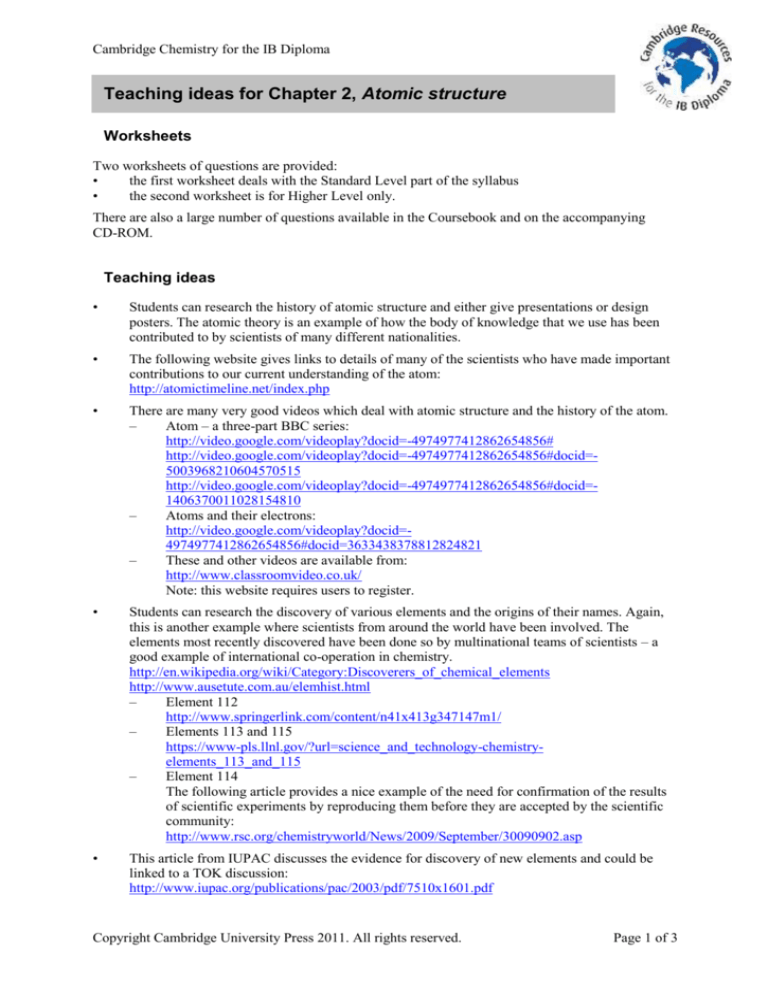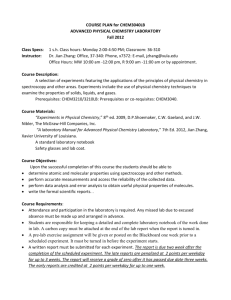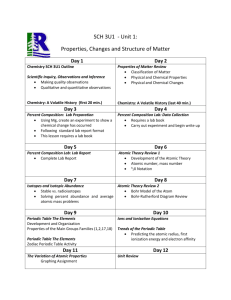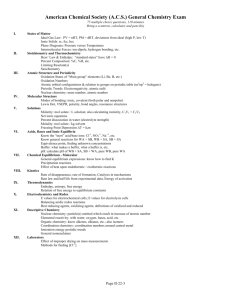
Cambridge Chemistry for the IB Diploma
Teaching ideas for Chapter 2, Atomic structure
Worksheets
Two worksheets of questions are provided:
•
the first worksheet deals with the Standard Level part of the syllabus
•
the second worksheet is for Higher Level only.
There are also a large number of questions available in the Coursebook and on the accompanying
CD-ROM.
Teaching ideas
•
Students can research the history of atomic structure and either give presentations or design
posters. The atomic theory is an example of how the body of knowledge that we use has been
contributed to by scientists of many different nationalities.
•
The following website gives links to details of many of the scientists who have made important
contributions to our current understanding of the atom:
http://atomictimeline.net/index.php
•
There are many very good videos which deal with atomic structure and the history of the atom.
–
Atom – a three-part BBC series:
http://video.google.com/videoplay?docid=-4974977412862654856#
http://video.google.com/videoplay?docid=-4974977412862654856#docid=5003968210604570515
http://video.google.com/videoplay?docid=-4974977412862654856#docid=1406370011028154810
–
Atoms and their electrons:
http://video.google.com/videoplay?docid=4974977412862654856#docid=3633438378812824821
–
These and other videos are available from:
http://www.classroomvideo.co.uk/
Note: this website requires users to register.
•
Students can research the discovery of various elements and the origins of their names. Again,
this is another example where scientists from around the world have been involved. The
elements most recently discovered have been done so by multinational teams of scientists – a
good example of international co-operation in chemistry.
http://en.wikipedia.org/wiki/Category:Discoverers_of_chemical_elements
http://www.ausetute.com.au/elemhist.html
–
Element 112
http://www.springerlink.com/content/n41x413g347147m1/
–
Elements 113 and 115
https://www-pls.llnl.gov/?url=science_and_technology-chemistryelements_113_and_115
–
Element 114
The following article provides a nice example of the need for confirmation of the results
of scientific experiments by reproducing them before they are accepted by the scientific
community:
http://www.rsc.org/chemistryworld/News/2009/September/30090902.asp
•
This article from IUPAC discusses the evidence for discovery of new elements and could be
linked to a TOK discussion:
http://www.iupac.org/publications/pac/2003/pdf/7510x1601.pdf
Copyright Cambridge University Press 2011. All rights reserved.
Page 1 of 3
Cambridge Chemistry for the IB Diploma
•
Students can research the use of radioisotopes. This could include looking at
radiocarbon dating of the Turin Shroud, Oetzi (the man in the ice) or Kennewick Man.
Details of other examples can be found at:
http://www.sciencedaily.com/releases/2011/04/110413121008.htm
www.radiocarbon.org/Journal/v37n1/jull.pdf
•
Students could further research the use of radioisotopes in the nuclear power industry and the
arguments for and against nuclear power. This could be related to Option E, Environmental
chemistry, where nuclear waste is discussed. Students could investigate which countries have
extensive nuclear power programmes and why.
•
It could be discussed how the colours of clothes look different in shops compared to when you
take them outside into daylight.
•
Practice with working out electronic configurations from the Periodic Table can be helpful.
•
Students can use a graphical method for calculating the ionisation energy for hydrogen. This
can either be done by using the Rydberg equation or using Application 1 on the Coursebook
CD-ROM, which generates the frequencies of lines. A graph of frequency change of
consecutive lines against frequency of line can be extrapolated to find the frequency at which
f = 0. E = hf can be used to convert this to an energy.
•
The fact that chemistry is an international subject could be discussed. For example, although
different nations may have different views of history, they all use the same atomic theory.
Practical activities
This topic does not lend itself to practical work, but some demonstrations can be carried out to
illustrate the principles of emission.
Safety
Extreme care must be exercised when carrying out any practical activities in the classroom and a risk
assessment should be conducted before carrying out the experiments.
Demonstrations
•
Atomic emission spectra may be demonstrated using a discharge tube and spectroscope.
Helium gives good results. Discharge tubes are available from specialist suppliers. The
discharge tube is connected to a high-voltage supply and viewed through a spectroscope in a
darkened room. The students can first of all look at the sky through the spectroscope, to show
the full continuous spectrum. They can then look at the discharge tube, to see that only a few
lines are present.
•
Alternatively, if a discharge tube is not available, students can look at fluorescent light tubes or
neon lamps using a spectroscope. Looking at the fluorescent light through a spectroscope shows
that they do not produce a complete spectrum.
•
Flame tests may also be used to illustrate emission spectra. Flame tests can be carried out by
dissolving samples of various ionic salts in ethanol and igniting on a watch glass or by using
the procedures given below.
http://www.practicalchemistry.org/experiments/flame-colours-a-demonstration,102,EX.html
http://www.chem.purdue.edu/bcce/Scaling_a_flashy_demonstration.pdf
Copyright Cambridge University Press 2011. All rights reserved.
Page 2 of 3
Cambridge Chemistry for the IB Diploma
Common problems
•
SL students can get a bit frustrated by the fact that the atomic theory that they study is
quite basic and it may be worth considering encouraging them to learn about orbitals, etc. This
can also be useful in some of the options, e.g. Option G, Further organic chemistry, where SL
students are expected to understand the electronic structure of benzene.
•
This topic is quite unusual at HL as, although it is probably the conceptually most difficult one,
it is a topic that students do not seem to find too difficult to understand.
•
The most difficult part of this chapter is the discussion on ionisation energies and students
generally need a great deal of practice on this.
ICT and simulations
•
Rutherford’s alpha particle scattering experiment:
http://www.mhhe.com/physsci/chemistry/essentialchemistry/flash/ruther14.swf
http://galileo.phys.virginia.edu/classes/109N/more_stuff/Applets/rutherford/rutherford.html
•
Build an atom:
http://phet.colorado.edu/en/simulation/build-an-atom
http://www.pbs.org/wgbh/nova/diamond/insidewave.html
•
More about atomic structure:
http://particleadventure.org/
•
Atomic spectra:
http://phet.colorado.edu/en/simulation/hydrogen-atom
http://phet.colorado.edu/en/simulation/discharge-lamps
http://www.mhhe.com/physsci/chemistry/essentialchemistry/flash/linesp16.swf
•
Application 1 on the Coursebook CD-ROM is a simulation of atomic spectra.
•
The emission spectra of elements are available at:
http://jersey.uoregon.edu/vlab/elements/Elements.html
•
Flame test colours and emission spectra are shown at:
http://webmineral.com/help/FlameTest.shtml
•
Electronic configurations:
http://intro.chem.okstate.edu/WorkshopFolder/Electronconfnew.html
http://www.colorado.edu/UCB/AcademicAffairs/ArtsSciences/physics/PhysicsInitiative/Physic
s2000/applets/a3.html
•
Atomic orbitals:
http://www.mpcfaculty.net/mark_bishop/AO_frame.htm
•
Application 2 on the Coursebook CD-ROM contains a database of successive ionisation energy
values for the first 20 elements, and can be used to create graphs showing these values.
•
Application 3 on the Coursebook CD-ROM can be used to create graphs of first ionisation
energies down groups in the periodic table.
Theory of knowledge (TOK)
The main issue here is which ways of knowing allow us to gain knowledge about atoms and atomic
structure.
Students could research the paradigm shifts that have occurred in our understanding of the nature of
matter. This could include researching phlogiston theory.
Copyright Cambridge University Press 2011. All rights reserved.
Page 3 of 3








